Clothes in Russian style

Long-term traditions in the way of life and rituals leave a certain imprint on clothes, shoes, hats and accessories of every nation. As a result, a unique, very recognizable style is created, by which it is easy to determine his belonging to a particular nationality.

When it comes to the Russian style of dress, it is, first of all, a riot of bright colors and ornaments, luxurious fur trim, long sundresses and many other details characteristic of the nationality.


Peculiarities
Among the items and details of clothing that are characteristic of the Russian style, one can note brocade trimmings, rich embroidery, a fur coat, a wide long skirt, a sundress, a painted scarf, a kokoshnik, and a blouse.





Today, many of these and other items characteristic of the Russian-folk style are out of fashion. However, in recent years, modern designers have been increasingly actively reviving old Russian traditions, offering to the audience entire collections of clothing for women, designed in folklore style.



Many designer clothes with elements of the old Russian style can be seen not only on the catwalk, but also in everyday life. For example, floor-length dresses with fluffy, embroidered skirts, fur vests, sleeveless jackets, colorful shawls, blouses.
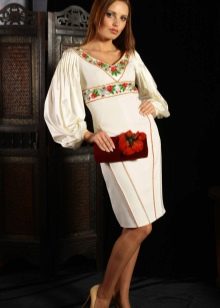


Bright colors and various ornaments always cause delight and interest among Europeans and representatives of other parts of the world. It is not for nothing that the "Russian style" has long since migrated outside our country and clothes made in this style can be seen in many countries of the world.


History
The Slavic or Russian style first became very popular about a hundred years ago, when, after the 1917 Revolution, part of the Russians left the country.At first, clothes in the Russian style began to be popularized in European countries, then this wave reached America.

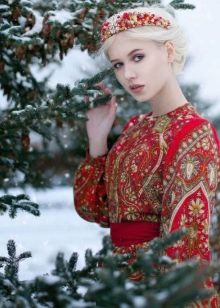
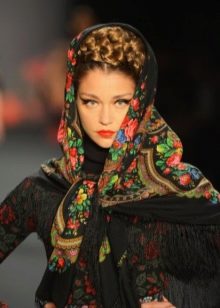
One of the most striking features of this garment is the layering. The harsh climatic conditions of Russia contributed to the fact that people put on several layers of different clothes at once.





The undershirt is a must-have for men and women. Most often it was sewn of linen. It had a simple, loose cut that did not restrict movement, and was tied with a belt.
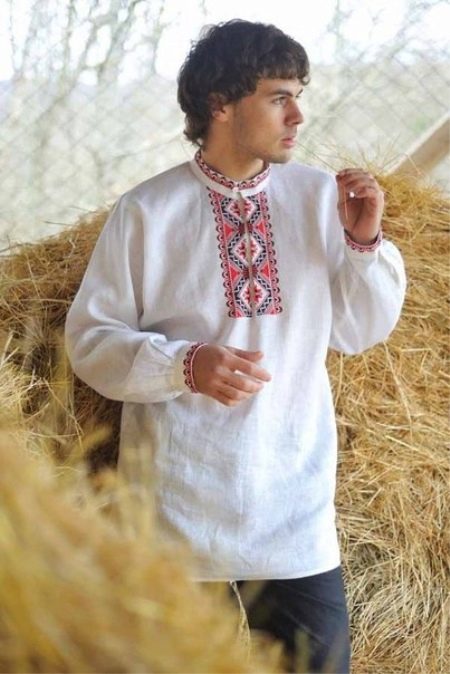
Poneva is an element of a woman's wardrobe. It was a wide, gathered skirt. It was used to give the body additional volume and insulation.



Sundress - women's clothing with a fairly loose cut. It expanded from the chest to the floor. The sundress was sewn from woolen, cotton or linen fabric. A scarf was thrown over the sundress or a soul warmer was put on.

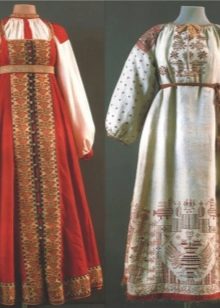

Outerwear. In rain or slush, an epancha, a sleeveless cloak, was worn over a sundress or shirt.

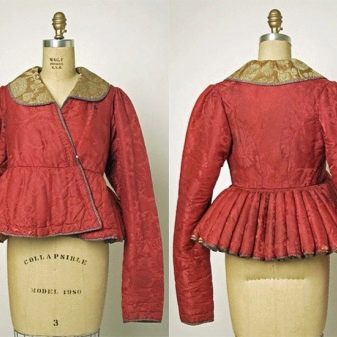
A fur coat served as winter clothing. Poor people sewed fur coats from sheepskin or hares, noblemen and nobles wore fur coats from sable, marten or fox. Winter clothes were long, expensive fur coats were additionally decorated with velvet and brocade.


Fur or knitted mittens were put on their hands, and their heads were covered with scarves or beanie hats.
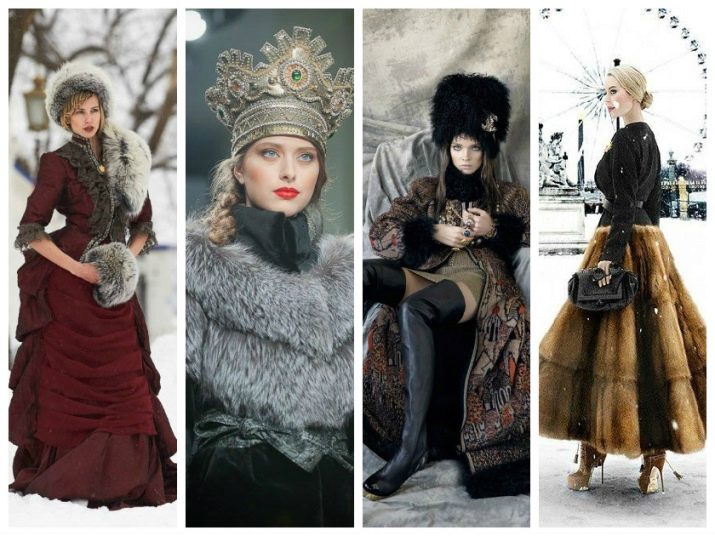
Among the striking distinguishing features of clothes made in the Russian style, the following points can be noted:
Style
As simple and comfortable as possible. Wide skirts, long sundresses, simple shirts. Only natural materials were used for sewing clothes: linen, cotton, chintz, wool.
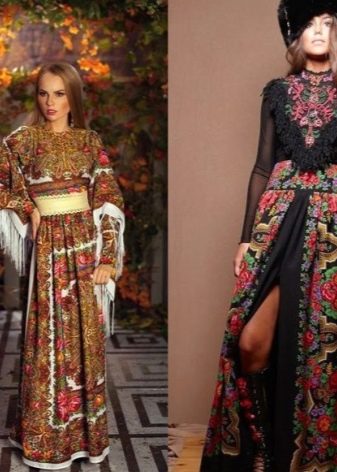
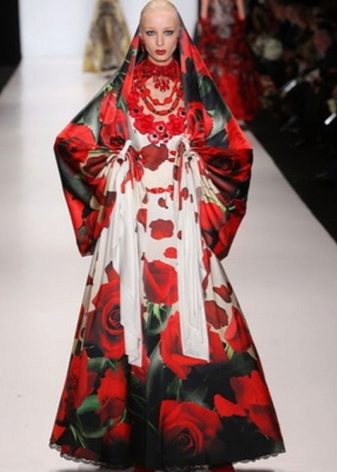
Costume elements
The collar was most often turned down and had a round shape. The sleeves were narrow, long or short lanterns. Women's or men's suits were often complemented by belts and lacing.



Color spectrum
Among the colors most used in Russian costume were yellow, red, white, black, green and blue paint. Golden hues were very common, especially in decoration, decor or accessories.

Ornaments
Floral patterns, birds, animals, Old Russian patterns are the most popular and most frequently used examples of clothing decorations. Ornamental figures were embroidered with gold and silver threads, decorated with bright ribbons, beads, multi-colored stones, lacing, lace or braid.



Patchwork clothing
Patchwork clothing is a separate part of the culture of the ancient Slavs. Today, the art of creating clothes or household items from colorful scraps of fabric is called patchwork. With the help of this technique, blankets, pillowcases, rugs were previously sewn. Today this style is actively used to create skirts, dresses, outerwear. And as bright, variegated shreds, Pavloposad shawls are often used.



Accessories
Bright beads, lush wreaths of wildflowers, ribbons woven into long braids, large colored beads, high kokoshniks, colorful shawls and painted scarves - this is just an incomplete list of decorations and additions to the Russian costume.






Modern designers see the "Russian style" in their own way and create their collections based on this vision. For example, Yves Saint Laurent was one of the first to appreciate the clothes in the Russian style and presented on the Paris catwalks the collection of outerwear, stylized as old sheepskin coats. Of course, the designer's models were more sophisticated and stylish than the original models. Shortened sheepskin coats were decorated with sable or marten fur edging and beautiful, rich embroidery.

Among other eminent masters, whose collections included clothes in the Russian style, one can note Valentino, Dolce & Gabbana, Jean Paul Gaultier, Vyacheslav Zaitseva, Valentin Yudashkin.





Selection Tips
In the hot summer, there will certainly be more than one reason to try on a bright, wide, long skirt with a floral pattern or a lush short sarafan.To make the image look stylish, and not be striking with an abundance of different colors and ornaments, it is best to choose plain clothes, shoes and accessories for such a skirt, sundress or dress. It can be a white or neutral top, blouse, T-shirt. Sandals and jewelry can match in color with one of the shades used in the "Russian" outfit.





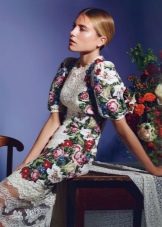

Noble and wealthy people in Russia sewed their clothes only from the most expensive and beautiful materials. If you want the image, designed in the Russian style, to look appropriate, the material, decor and other additions should not look cheap. It is good if these are natural fabrics, fur and expensive, various decorations.





What to wear with?
To create an image "in Russian style" it is not at all necessary to completely dress in traditional Russian clothes. One item will be enough, for example, a sundress, a blouse, a fur vest or a wide colored skirt.


A snow-white blouse with puffy lantern sleeves is perfect for a bright red lush sarafan embroidered with flowers. Red sandals or shoes will harmoniously complement the stylized look. As an accessory, you can pick up a wide hairband or beautiful large beads.



It is preferable to leave a long fluffy dress decorated with Russian ornaments for a gala evening. But a fluffy multi-colored skirt is perfect for every day. It is best to choose a top, blouse or T-shirt for such a skirt in a calmer, restrained color.

When it comes to outerwear in the Russian style, it is, first of all, sheepskin coats, fur coats, coats with fur trim, scarves, hats, felt boots.






A small cross-stitch can easily transform a boring everyday bow. You can decorate the sleeves of a blouse, a pocket of a shirt, a skirt or your favorite jeans with a laconic ornament.





A painted Pavlo Posad shawl will help you quickly add brightness to your everyday look. It can be thrown on like a shawl or beautifully tied around the head.





Spectacular images
The Russian style of dress is not only colorful sundresses or fur warmers. A laconic black jumper and dress are decorated with a lush bouquet of bright roses. Red leggings are perfectly combined with such an outfit, and a luxurious Russian braid helps to more accurately match the image.

Gorgeous long dresses, decorated with patterns in the style of Gzhel patterns, will become a worthy alternative to the usual black evening dresses.
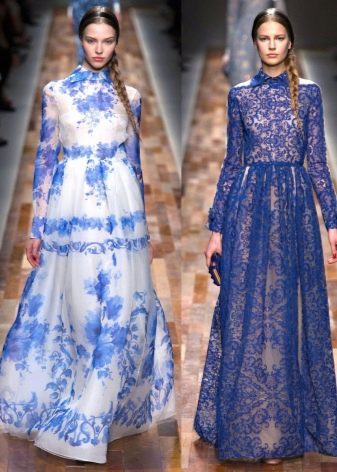

A snow-white blouse with puffed sleeves and a gathered round neckline, made in a folk style. Blue-blue roses, lacing and a belt with tassels are used as decoration. Such a stylized model looks great against the background of a classic black skirt.









